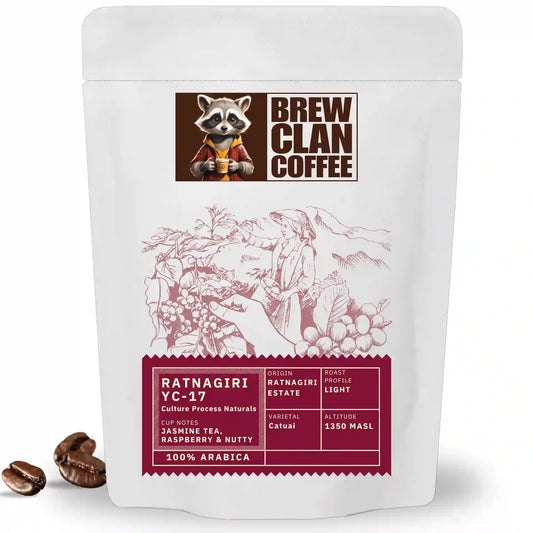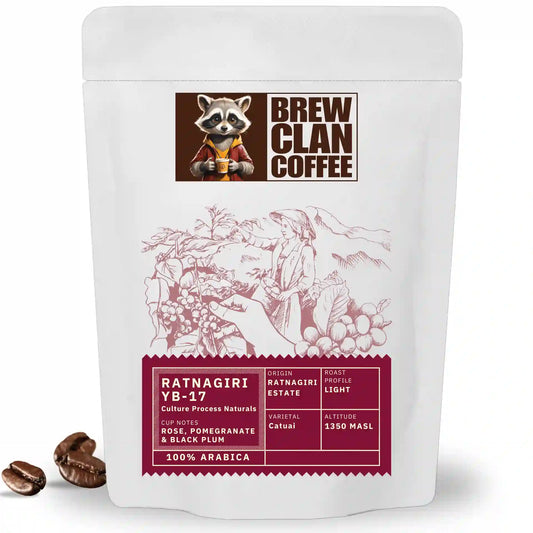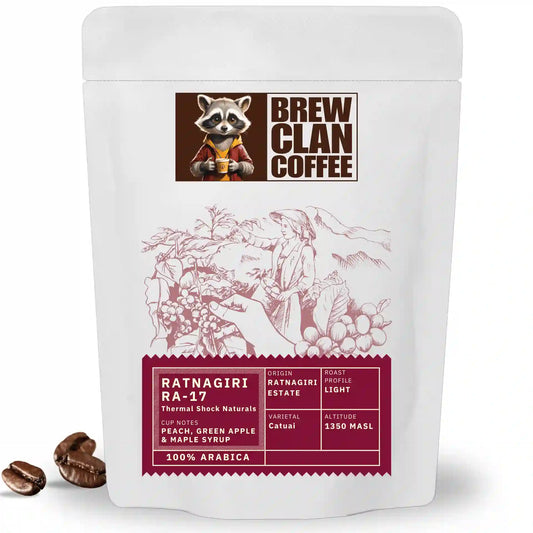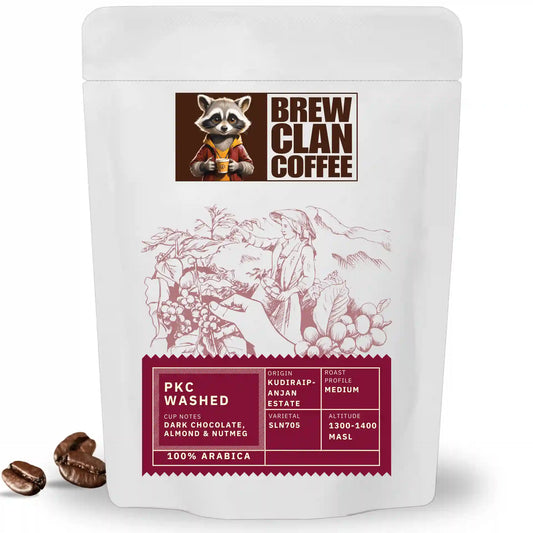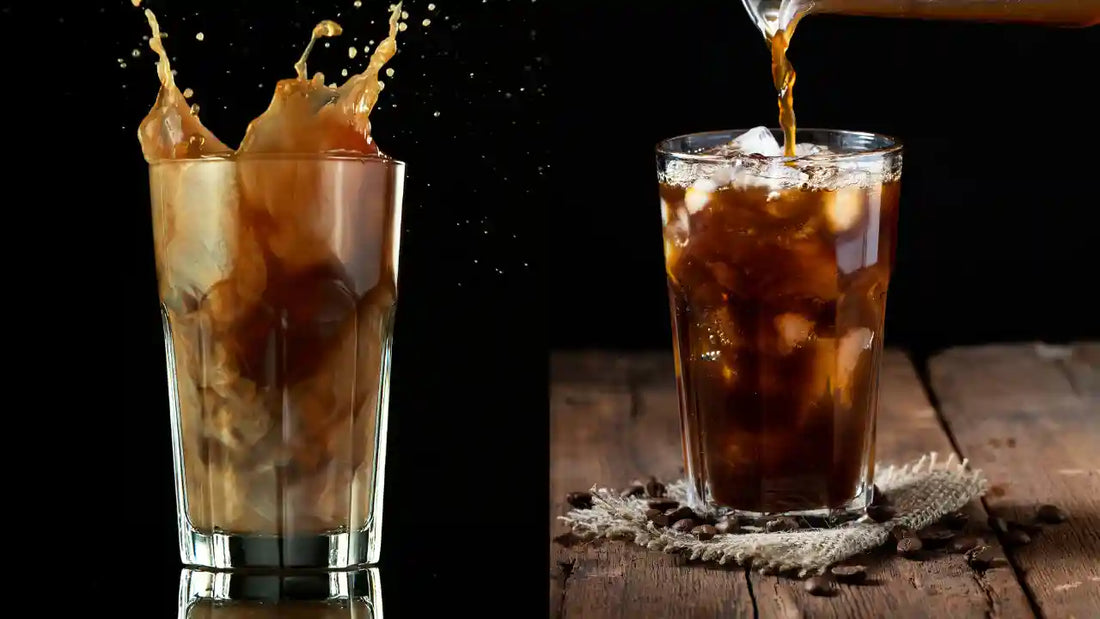
Cold Brew vs. Iced Coffee: What’s the Real Difference?
Share
Cold Brew vs. Iced Coffee. Both are served cold. Both look the same in a glass. But cold brew and iced coffee are not the same drink and if you’ve ever taken a sip expecting one but got the other, you know exactly what we mean.
Cold brew is smooth, mellow, and low-acid. Iced coffee is sharp, bright, and fast to make. Yet many people still use the terms interchangeably, leading to confusion, disappointment, or just an underwhelming coffee experience.
In this blog, we’ll break down:
- What exactly cold brew and iced coffee are
- How they differ in brewing methods, taste, caffeine, and acidity
- When to choose one over the other based on your mood, time, and taste buds
Whether you’re trying to make a better cold cup at home or just want to know what you’re ordering at a café, you’re in the right place.
What Is Cold Brew Coffee?
Cold brew is made by steeping coarse coffee grounds in cold or room-temperature water for a long period, typically 12 to 24 hours. The result is a coffee concentrate that’s later diluted with water, milk, or ice before drinking.
Unlike other brewing methods, no heat is used at any stage. This slow, gentle extraction process pulls out different flavor compounds, resulting in a smooth, mellow, and naturally sweet cup of coffee.
Key Characteristics of Cold Brew:
- Brew time: 12–24 hours
- Grind size: Coarse
- Acidity: Very low, easy on the stomach
- Flavor: Smooth, chocolatey, nutty, mellow
- Shelf life: Can be stored in the fridge for up to 7–10 days
Cold brew is ideal for people who prefer a gentler, less acidic coffee, or want to batch brew a few days in advance. It also pairs beautifully with milk or cream due to its bold yet soft body.
What Is Iced Coffee?
Iced coffee is exactly what it sounds like: hot-brewed coffee that’s been cooled down and served over ice.
You can brew it using any hot method, drip machine, pour over, French press, and then chill it in the fridge or pour it directly over ice. Some people brew it stronger than usual to compensate for the dilution caused by melting ice.
Unlike cold brew, iced coffee starts hot, which means it extracts different flavor compounds from the beans, often resulting in a brighter, more acidic, and more aromatic cup.
Key Characteristics of Iced Coffee:
- Brew time: ~5 minutes (plus cooling time)
- Grind size: Depends on the brewing method (medium for drip, coarse for French press, etc.)
- Acidity: Higher than cold brew
- Flavor: Brighter, more vibrant, sometimes tangy or fruity
- Shelf life: Best consumed fresh; loses flavor quickly
Iced coffee is a great choice when you want a cold drink but don’t want to wait overnight, and when you enjoy the lively, sharp flavors of a classic hot brew served cold.
Key Differences Between Cold Brew and Iced Coffee
At a glance, cold brew and iced coffee might look the same in a glass, but they’re worlds apart in how they’re made, how they taste, and how they feel in your body. Here’s how they truly differ:
Brewing Method
- Cold Brew: Steeped slowly in cold or room-temperature water over 12–24 hours
- Iced Coffee: Brewed hot (in minutes), then cooled and served over ice
Time to Brew
- Cold Brew: Requires advance planning; overnight or longer
- Iced Coffee: Can be made fresh in 5–10 minutes
Flavor Profile
- Cold Brew: Smooth, mellow, chocolatey, low bitterness
- Iced Coffee: Bright, acidic, punchy; closer to hot coffee in taste
Acidity
- Cold Brew: Low acidity - easier on the stomach
- Iced Coffee: Higher acidity - may taste sharper or tangier
Caffeine Content
- Cold Brew: Often higher (especially when undiluted), as it’s brewed as a concentrate
- Iced Coffee: Typically less caffeine per ounce, depending on brew strength
Shelf Life
- Cold Brew: Lasts up to 7–10 days in the fridge
- Iced Coffee: Best when fresh, loses flavor if stored
When to Choose Each
- Cold Brew: When you want a smooth, low-acid drink, or want to prep ahead
- Iced Coffee: When you want a quick cold cup with lively flavor
Comparison Chart: Cold Brew vs. Iced Coffee
|
Feature |
Cold Brew |
Iced Coffee |
|---|---|---|
|
Brew Method |
Steeped in cold/room temp water (12–24 hrs) |
Hot brewed, then chilled |
|
Brew Time |
12–24 hours |
~5 minutes (plus cooling) |
|
Flavor Profile |
Smooth, mellow, chocolatey |
Bright, vibrant, sharper |
|
Acidity |
Low |
Higher |
|
Caffeine |
Higher (especially undiluted) |
Moderate |
|
Best For |
Prepping ahead, low-acid coffee |
Quick brews, punchy flavor |
|
Storage |
Lasts up to 10 days in fridge |
Best consumed fresh |
|
Best Beans |
Medium–dark roasts |
Light–medium roasts |
Which One Has More Caffeine, Cold Brew or Iced Coffee?
This is one of the most common questions, and the answer is: it depends.
Cold Brew can have more caffeine
Cold brew is typically made as a concentrate, using a high ratio of coffee to water. When undiluted, it’s much stronger than most coffee beverages.
Even when diluted, cold brew often retains a higher caffeine content per serving compared to standard iced coffee.
But there’s a catch.
Caffeine depends on:
- Coffee-to-water ratio
- Brew time
- Bean origin and roast level
- Whether the cold brew is diluted before drinking
Iced Coffee has less, but still plenty
Since iced coffee is brewed hot using normal ratios and then chilled, it generally contains less caffeine per ounce than cold brew concentrate. However, it’s still enough to give you a good kick, especially if brewed strong or consumed in larger servings.
So what’s stronger?
Cold Brew (especially undiluted): 🔥🔥🔥
Iced Coffee: 🔥🔥
If you’re sensitive to caffeine or drinking late in the day, you may want to dilute your cold brew or choose iced coffee instead.
Taste & Acidity: Which One’s Gentler on the Stomach?
One of the biggest practical differences between cold brew and iced coffee is acidity and for many people, this can be the deciding factor.
Cold Brew: Naturally Low in Acidity
Because cold brew is never exposed to heat, it extracts fewer acidic compounds than hot-brewed methods. The result is a cup that’s:
- Smoother
- Rounder
- Easier on sensitive stomachs
If you often find yourself with heartburn or digestive discomfort after drinking coffee, cold brew might be a better option for you.
Iced Coffee: Bright but Sharper
Since it’s brewed hot and then cooled, iced coffee retains much of the acidity and sharpness typical of hot coffee.
This gives it a more vibrant and tangy flavor, but it may also feel a bit harsher, especially on an empty stomach.
That said, acidity is also what makes iced coffee feel bright, lively, and crisp. If you enjoy that zing, iced coffee is worth exploring.
Tip: Acidity ≠ Bitterness
Many confuse the two, but they’re different. Acidity brings brightness; bitterness usually comes from over-extraction or dark roasts. Cold brew reduces both, which is why it’s so popular for smooth sipping.
When to Choose Cold Brew vs. Iced Coffee
So you’ve learned the differences, but how do you choose between the two? It often comes down to your mood, schedule, and flavor preference.
Here’s a simple breakdown to help you decide:
✅ Choose Cold Brew If:
- You prefer a smooth, mellow, less acidic taste
- You want to make coffee ahead of time and store it for the week
- You enjoy adding milk, cream, or sweeteners without overwhelming the coffee
- You need a strong caffeine boost that hits slow and smooth
- You’re sipping it on-the-go or from the fridge
✅ Choose Iced Coffee If:
- You like a brighter, sharper flavor closer to hot coffee
- You want a quick cold coffee fix without waiting hours
- You enjoy your coffee black or lightly sweetened
- You’re using leftover morning brew or just brewing for the moment
- You’re drawn to that zingy, refreshing lift
There’s no wrong choice, just different coffee for different days.
Some mornings call for crisp iced coffee. Others need the calming, slow-brewed depth of cold brew.
BrewClan Tip: Fresh Beans Make Both Better
Here’s something many people overlook:
The beans you use matter more than the brewing method.
Whether you’re making cold brew or iced coffee, you’ll taste a world of difference when you start with freshly roasted, specialty-grade beans.
For Cold Brew:
Go for medium to dark roasts with chocolate, nutty, or caramel notes. These flavors become smooth and naturally sweet after cold steeping.
For Iced Coffee:
Try light to medium roasts with fruity or citrus notes. The brightness of these beans shines when brewed hot and chilled.
At BrewClan, we roast in small batches and ship fresh, so your cold coffee isn’t just cold… it’s exceptional. Whether you’re steeping overnight or pouring over ice, our beans are crafted to bring out the best in your brew.
Explore Our Roasted Coffee Collection — Try it once, and you’ll taste the difference.
FAQs - Frequently Asked Questions
1. Is cold brew stronger than iced coffee?
Yes, cold brew is usually brewed as a concentrate and can contain more caffeine per ounce, especially if undiluted.
2. Which is less acidic: cold brew or iced coffee?
Cold brew is significantly less acidic than iced coffee because it’s brewed without heat, making it gentler on the stomach.
3. Can I use the same beans for cold brew and iced coffee?
Absolutely. But for best results, use medium-to-dark roasts for cold brew and light-to-medium roasts for iced coffee to highlight their strengths.
4. How long does cold brew last in the fridge?
Cold brew concentrate can last 7–10 days when stored properly in an airtight container.
5. Can I make iced coffee with leftover hot coffee?
Yes! Leftover hot coffee can be chilled and poured over ice for a quick iced coffee, though the flavor may not be as fresh.
6. Which is faster to make: cold brew or iced coffee?
Iced coffee wins this one, it takes just minutes. Cold brew requires 12–24 hours of steeping time.

